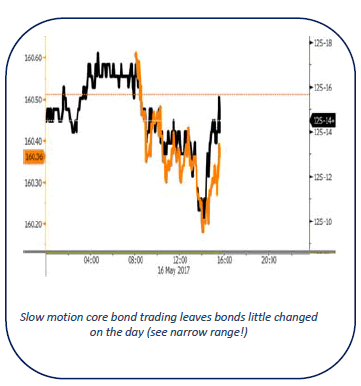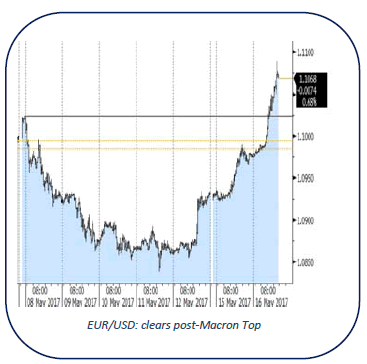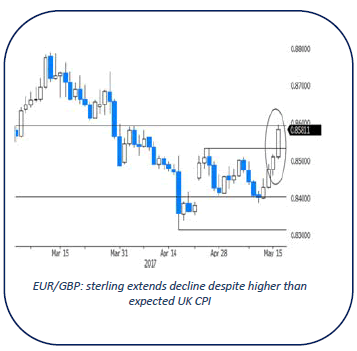Headlines
European equities meandered in slightly negative territory during the morning session, but are currently again near flat levels for the day. US equities open marginally higher, shrugging off the Trump story.
UK inflation resumed its upward march last month, boosted by the price of air fares, clothing and energy. Consumer prices rose from 2.3% Y/Y to 2.7% Y/Y (vs 2.6% Y/Y expected), the fastest pace since September 2013. Underlying, core CPI accelerated from 1.8% Y/Y to 2.4% Y/Y and also PPI data beat expectations.
Central European Q1 GDP data printed very strong, beating consensus: Romania 1.7% Q/Q, Czech Republic and Hungary 1.3% Q/Q, Poland 1% Q/Q and Bulgaria 0.8% Q/Q. Local currencies rallied against a strong euro with CZK at the strongest level since the CNB ended its intervention regime and PLN at the strongest rate since end 2015.
The mood among German investors improved further in May, with the ZEW-indicator reaching its highest since July 2015, in a further sign that political uncertainties which have clouded the growth outlook for Europe’s biggest economy are evaporating. The forward looking expectations component rose less than expected though.
US housing starts & permits disappointed in April as both fell about 2.5% to respectively 1172K and 1229K. The housing series are volatile and starts & permits are at high levels. Therefore, one shouldn’t draw conclusions from the miss. Industrial production on the contrary sharply outperformed expectations being up 1% in April both for the overall figure and for the manufacturing output. A sign Q2 GDP will rebound after a lacklustre Q1.
The Riksbank is considering changing the measure used for its inflation target to one that is less affected by interest rate changes (CPIF), and introducing a "variation band" of plus or minus one percentage point from the official 2% target. The proposals are expected to be implemented after the central bank’s September policy meeting.
OPEC and its oil-producing partners may have to do more than merely extend their petroleum-output cuts to achieve their goal of rebalancing global supply and demand, the International Energy Agency said. In the run up to the cuts, OPEC pumped so much oil that storage levels rose, delaying the rebalancing.
Europe’s top court has said EU member states must sign off on some issues related to investment in a key trade deal with Singapore, in a judgment that could set a precedent for a post-Brexit trade pact with the UK.
Rates
Core bonds barely changed in thin trading
Global core bonds lost slightly ground in another session without firm direction. Core bonds are in consolidation mode awaiting new important impetus. Other markets didn’t impact core bonds. Oil gained slightly for the fifth consecutive session, but is off the intraday highs and the daily momentum is slowing. European equities are near opening levels, erasing initial small losses. FX market showed more dynamics with euro strength and dollar weakness.
Intraday, the Bund opened slightly higher as some modest risk-off sentiment reigned in Asia after the latest Trump story on revealing intelligence information to the Russian minister of foreign affairs. However, European equities barely fell in the opening and stabilized soon. EMU data (GDP, trade and ZEW sentiment) confirmed the strength of the euro area recovery, but actually didn’t reveal much extra new info. Supply was an issue with new long bonds from France and UK in size. The issuance was well received, but nevertheless weighted somewhat on the longer end. Technical players eyed the 160 level in the Bund (correction low) which in case of a break would open the road to levels around 158.80 (10- yr yield high 0.50%). However, the Bund never made it to 160 (160.17 intra-day low). US housing starts and permits disappointed. In today’s thin trading, they exceptionally caused a soft bounce that erased the T-note’s (small) losses and lifted the Bund off the intraday lows. Strong industrial production data didn’t change the picture. Later today, ECB Nowotny and Coeuré still speak.
At the time of writing, German yields increased by 1.3 bps (2-yr) to 1.5 bps (30- yr). The French debt agency successfully launched a syndicated 31-yr benchmark (May2048) (see below). US yield changes are narrowly mixed between +0.4 bps (2-yr) and -0.1 bp (30-yr). On intra-EMU bond markets, 10-yr yield spread changes versus Germany r narrowed 3,4 and 5 bps for Spain, Italy and Portugal.
France has attracted in excess of €30B of orders for a new 31-yr OAT bond, in a rapturous investor reception for the country’s debt after the presidential election concluded last week. The "Trésor" finally printed €7B of its new 3.25% May 2048 OAT. France outperformed Belgium by 2 bps at the 30-yr tenor as a consequence of the successful launch.

Currencies
EUR/USD clears 1.1023 resistance
EUR/USD cleared 1.1023 resistance today. The move was due to USD weakness on recent Trump-related issues and on disappointing US eco data. At the same time, political sentiment on the euro stays constructive. EUR/USD trades around 1.1075. The loss of USD/JPY remains modest as US equities stay resilient despite all kinds of political and economic noise from the US.
Overnight, Asian equities took a strong start after WS’s record race, but the momentum dwindled as US President Trump revealed classified information to the Russian foreign minister. USD/JPY retreated off the early Asian highs (113.80) and returned to the mid 113 area. EUR/USD buying persisted and brought the pair within reach of the 1.10 barrier
The EUR/USD rally accelerated from the start in Europe. Uncertainty on the ability of the Trump’s administration to implement a coherent policy and recent disappointing US eco data caused further USD selling. At the same time, the euro profited from constructive political sentiment after yesterday’s meeting between German Chancellor Merkel and French president Macron. The DAX set a new all-time top and investors squeezed EUR/USD north of the 1.1023 post- Macron top. Interest rate differentials between the US and Germany/Europe held near the recent lows, but declined only marginally further. US housing starts again missed consensus and failed to rebound from a poor performance last month. EUR/USD set a correction top (1.1089 )after the housing data. However, mid-morning, the US production data were much stronger than expected. The report has only a limited impact on the dollar, but prevents further USD losses. EUR/USD trades in the 1.1075 area. USD/JPY eased below 113.50 after the housing data but for now US equities remain immune for negative US news. This equity resilience prevents further USD/JPY losses.
The Swedish Crown declines further (EUR/SEK 9.73 currently) as the Risksbank proposed a change in its policy framework, allowing a range of 1% around the CPIF 2% inflation target. Markets interpret this as the central bank opening the door to keep policy easy even if inflation overshoots the target.

EUR/GBP clears 0.8509/31 resistance despite higher CPI
UK April inflation printed at 2.7% Y/Y today (from 2.3% Y/Y in April while 2.6% Y/Y was expected). Core inflation rose to 2.4% Y/Y (from 1.8% Y/Y) and was also a touch higher than expected. The data were unable to support sterling though. On the contrary, euro strength dominated. EUR/GBP already tested 0.8509/31 resistance and the move accelerated after the CPI data. The technical break and broad-based euro strength reinforced EUR/GBP buying. The pair trades currently in the 0.8580/85 area. Cable also failed to gain any ground despite overall USD softness. A decision of the EU Court of Justice on the EU free trade agreement with Singapore probably also weighed on sterling. The court ruled that the agreement needs to be approved by national parliaments. The ruling raised the chance that national parliaments will also have an important say in the approval of a EU-UK trade deal, making the outcome more uncertain. Whatever the reason, cable also reversed initial gains despite higher than expected UK inflation. The pair trades just below 1.29. Overall, today’s price action suggests a further deterioration of sterling sentiment.













